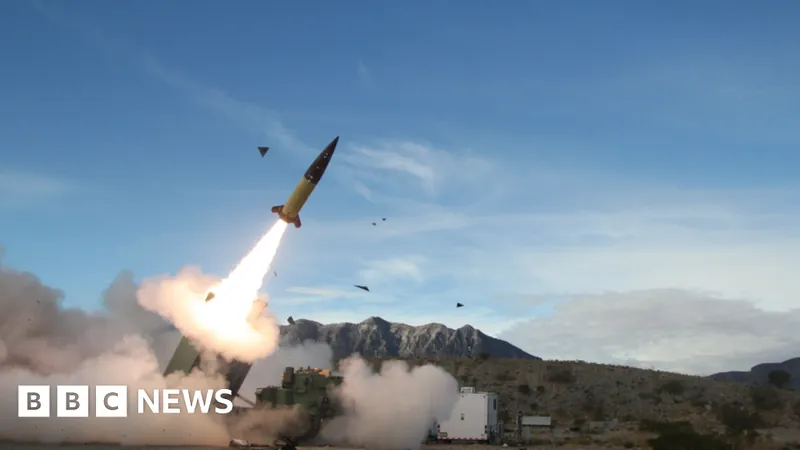
Biden Opens Doors for Ukraine to Target Russia with Long-Range Missiles! What This Means for the War
2024-11-18
Author: Lok
Introduction
In a dramatic shift in U.S. foreign policy, President Joe Biden has authorized Ukraine to use American-supplied long-range missiles, specifically the ATACMS, to strike Russian targets. This decision marks a pivotal moment in the ongoing conflict, as Washington had previously resisted Ukraine's calls for permission to carry out cross-border strikes for months.
Reactions and Implications
Reacting to the announcement, Ukraine's President Volodymyr Zelensky stated, “Such things are not announced; missiles speak for themselves.” This underscores the seriousness of the situation and suggests that Ukraine is prepared to leverage this new capability on the battlefield.
President Vladimir Putin has long warned Western nations against escalating their involvement in what he refers to as a “proxy war.” He has indicated that allowing Ukraine to strike inside Russia would be tantamount to NATO's direct participation in the conflict. Although he has not yet commented on Biden's recent decision, Kremlin officials have labeled it a dangerous escalation.
Strategic Considerations
The Biden administration has framed the use of the ATACMS as a defensive measure aimed primarily at the Kursk region of Russia, where Ukraine reportedly carried out a surprise incursion in August. This shift in policy may empower Ukraine to hold on to a small portion of Russian territory, which could serve as a strategic bargaining chip in potential peace negotiations down the line.
Security expert Serhiy Kuzan from the Ukrainian Security and Cooperation Centre described this authorization as “very important,” emphasizing that while it may not drastically change the trajectory of the conflict, it will level the battlefield for Ukrainian forces as they continue to defend their nations.
Capabilities of ATACMS
The ATACMS has an impressive range of up to 300 kilometers (186 miles), allowing Ukraine to target key military assets deep within Russian territory. Unnamed U.S. officials revealed that this decision came in response to reports of North Korean troops being deployed to assist Russia, adding another layer of complexity to the war dynamics.
Implications of North Korean Involvement
Kuzan further highlighted that this decision precedes an expected offensive by Russian and North Korean troops aiming to dislodge Ukrainian forces from Kursk. Reports estimate about 11,000 North Korean soldiers are currently stationed in the region, reinforcing Ukraine's urgency in acquiring advanced capabilities.
Allied Support for Ukraine
Additionally, Biden's approval could pave the way for allied nations like the UK and France to provide Ukraine with long-range Storm Shadow missiles, amplifying Ukraine's firepower. Neither country has issued a statement on this development yet.
Continued Struggle on the Battlefield
Last month, Zelensky confirmed the successful use of U.S.-made long-range missiles for the first time against Russian targets, showcasing the effectiveness of international military aid. However, the battle remains fierce, especially in the eastern Donetsk region where Russian forces are gaining ground towards Pokrovsk, a critical supply hub.
Escalation of Drone Warfare
Furthermore, Russia has escalated its drone warfare tactics, reportedly launching over 2,000 drone strikes in October alone—a record for the conflict. The intensity of ongoing assaults continues to inflict casualties, with recent strikes resulting in multiple deaths in Ukrainian regions near the border.
Future of U.S. Support for Ukraine
As President Biden approaches the end of his term in January, there are growing concerns about the future of U.S. support for Ukraine, especially with the looming possibility of Donald Trump returning to the presidency—who has publicly criticized military assistance as a strain on U.S. resources.
To date, the U.S. has emerged as Ukraine’s largest weapons supplier, committing over $55.5 billion in military aid as of mid-2024, according to the Kiel Institute for the World Economy, a German think tank. Biden’s latest move reflects a continuing commitment to support Ukraine, but the stakes are higher now than ever as the conflict shows no signs of abating. Will this new strategy lead to a turning point in the war? Only time will tell.



 Brasil (PT)
Brasil (PT)
 Canada (EN)
Canada (EN)
 Chile (ES)
Chile (ES)
 España (ES)
España (ES)
 France (FR)
France (FR)
 Hong Kong (EN)
Hong Kong (EN)
 Italia (IT)
Italia (IT)
 日本 (JA)
日本 (JA)
 Magyarország (HU)
Magyarország (HU)
 Norge (NO)
Norge (NO)
 Polska (PL)
Polska (PL)
 Schweiz (DE)
Schweiz (DE)
 Singapore (EN)
Singapore (EN)
 Sverige (SV)
Sverige (SV)
 Suomi (FI)
Suomi (FI)
 Türkiye (TR)
Türkiye (TR)